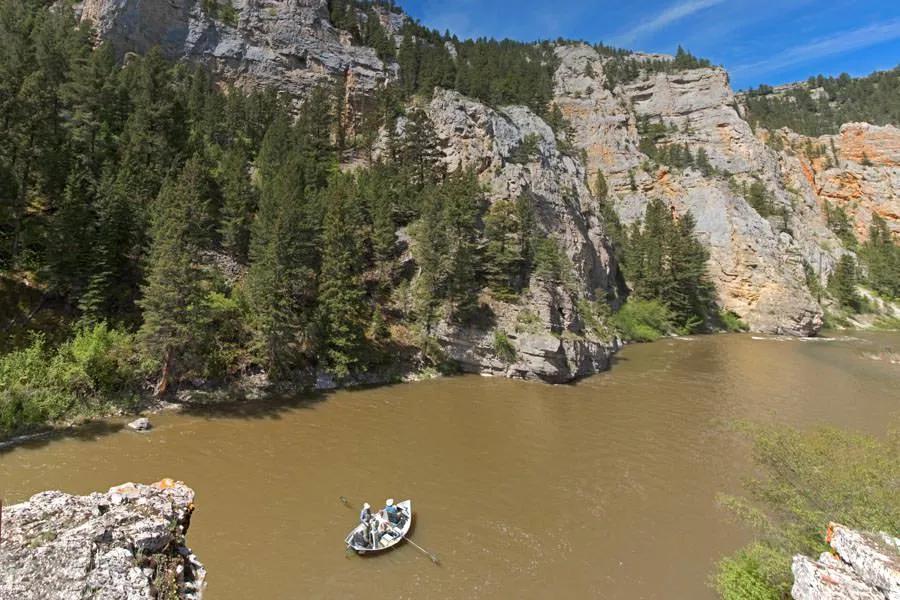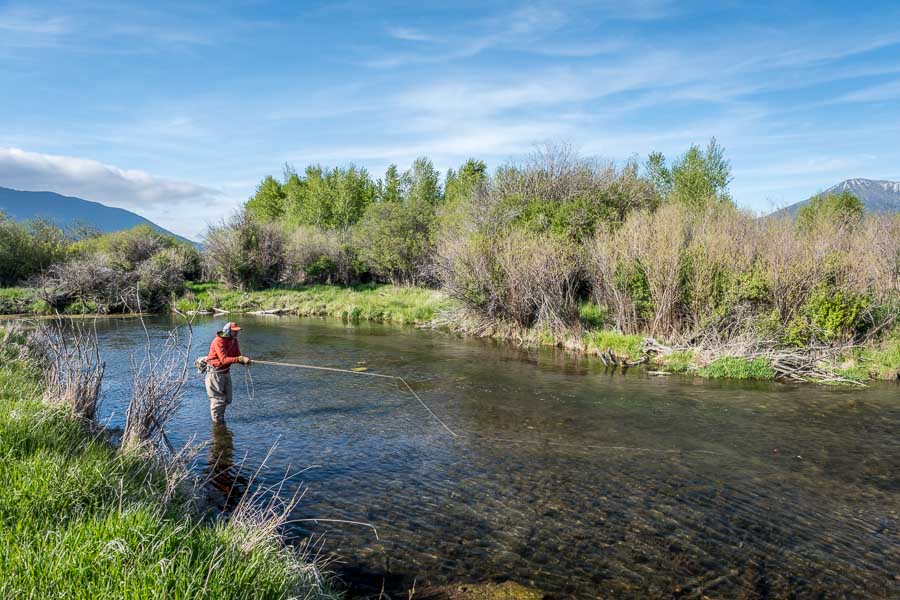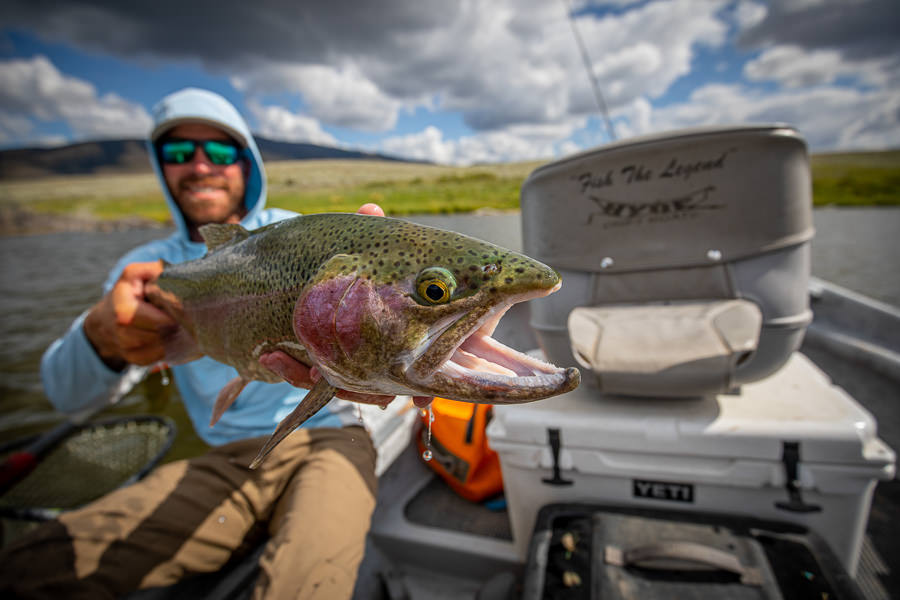
As we hit the latter stages of winter and cabin fever has fully overtaken, many of us start daydreaming about the warmth of spring sun and fishing. Whether you live in Montana or are maybe planning a fly-fishing trip to Montana, one factor that we all must account for when making our fishing plans in the spring is run-off. Now there is some excellent fishing to be had early spring before the snow melt begins, but what do we do when a lot of rivers are swollen from the additional water from melting snow out of the mountains? Run-off, or the period when the temperatures warm and snow melts and drains into the river valleys is a double edge sword. Sure, it can be frustrating when you can’t fish your favorite river for almost two months because the water is two high and dirty. Run-off is also a big part of what makes our rivers such great fisheries. The snowpack we get during the winter and subsequent runoff are what lead to fruitful summers of excellent fishing, great water levels and cool water temps, all the ingredients for happy trout and fly-fishermen. During this period a lot of freestone rivers become unfishable, and too dangerous to fish with their swift currents, but armed with the right info a fly angler can enjoy some exceptional fishing during this time. This time of year, most rivers see minimal fishing pressure, and with air and water temps rising trout’s metabolisms kick in the gear after a long somewhat dormant winter, making for some excellent angling opportunities.
1. Fish tail waters
One of the first places to find some great run-off fishing is tailwaters. A tail water river is a waterway that has large reservoirs and dams that help keep run-off in check, unlike a freestone river which has no way to regulate the influx of water. The biggest advantage these dams give rivers is that the reservoirs help to filter out large amounts of sediment that get washed into the rivers.

Also, many of these dams allow the river flows to be somewhat controlled and stay at fishable levels. Rivers such as the Bighorn, Beaverhead and Missouri are some of the most famous tailwaters in the world. The Ruby and Madison rivers are also tailwaters that fish very well during most of run off. Tailwaters also typically lend themselves to excellent bug life especially mayflies. Also due to the more stable water flows trout behavior can be much more predictable once you figure out their habits on a given river.
2. Fish spring creeks
Spring creeks are some of my favorite waters to fish year-round, but especially during run-off. The beauty of true spring creeks is that their water source comes from underground aquifers, creating a stream that is unaffected by run-off, stays crystal clear, with consistent and almost constant water temperatures year-round. If you have never fished a spring creek you owe it yourself to go. Montana is home to some of the most famous spring creeks in the world, some of which are a short ride from Bozeman. Due to the consistent water temperatures these bodies of water have excellent bug life and are some of the first to see consistent hatches of the year. Also, trout love to seek refuge from the cold of winter and the high waters of spring in the spring creeks the terminate into larger freestone and tailwater rivers.

One of the most sought-after mayfly hatches in the west is the PMD (Pale Morning Dun) hatch. These mayflies begin their emergence right at the peak of run-off and can provide unparalleled dry fly action on the spring creeks. Most of the springs creek around the state are located on private land and are set up as a pay to play scenario. One of the downsides is that they can become quite popular during the peak of run-off and most of them only allow a certain number of fishermen per day. You will want to make sure that you plan ahead and pre book your spring creek days well in advance. Also due to the characteristics of spring creek fishing you may want to hire a guide for your first go. Fishing can be very technical and challenging, being able to tap into a guide’s wealth of knowledge can really help in cutting down the learning curve.
3. Fish still waters
Lake fishing is often overlooked by many fly fishermen. When most folks envision fly fishing, they think of standing in a flowing river catching trout, fishing lakes and ponds doesn’t even cross their mind. I urge anyone who loves to fly fish for trout, especially large trout to give a day of lake fishing a shot, you will not be disappointed. During run-off lake fishing can be spectacular.

The fish in the lakes are just waking up from a cold winter and are looking to feed and pack on the pounds. One of my favorite parts of lake fishing this time of year is that the fish will typically cruise the shallow water of the lake in search of food. This creates the exciting opportunity to sight fish to trout sometimes well over 24 inches in length. In springtime the lake’s weed beds haven’t yet established themselves and allows for great fishing opportunities. To me it has some resemblance to saltwater fishing on the flats. Stalking targets and making precise casts to large trout. While sight fishing for large trout with streamers can be exciting, by June the first brood of callibaetis mayflies start to hatch and can lead to some exceptional dry fly fishing as well. In short even though lake fishing may have not been on your radar a Montana fly fishing option it should not be overlooked.
4. Fish the high water
Run-off can cause rivers to rise well above their banks, make the water muddied and fishing dangerous if not impossible. But with a little bit of knowledge and timing fishing in the high water can be quite advantageous. Early on into run off we still can get some pretty good cold snaps that come in. If the temperatures drop especially in the mountains can put a momentary stop to run off. Opening up a small window of fishable water. If we get a run of cold weather, it will cause the snow in the mountain to refreeze and stop from melting. This is can create some great fishing opportunities for those in the know. The key here is to watch the weather and the water gauges. If you are paying attention you can find yourself with a two- or three-day window to get out and fish on the bigger rivers, and if you hit it right the fishing can be lights out. Typically, when water levels are rising, and visibility is poor fishing is slow to nonexistent.

As spring rolls on run-off will eventually hit its peak and begin to subside. As soon as the river levels begin to decline, and visibility hits 12” it's time to fish. Now the rivers will still be big, but the fishing is excellent. You will be fishing to fish that haven’t seen a fisherman or been hooked in the last two months and they are ready to feed. It’s during this time that the use of a drift boat is paramount. One nice thing about fishing in high water is that it makes finding fish easier. Trout can not hold in the very fast water and will seek out shelter in large eddies and soft water pockets along the shore. A favored tactic of our Bozeman fly fishing guides is to use their drift boats to maneuver and travel downstream. Once they identify what looks like good holding water for trout, they will drop anchor, get out and pick apart that piece of water. They will spend the day moving from pocket to pocket. The boat allows them to cover a lot of water and hit as many pieces of holding water as they can. Typically leading to very successful fishing days.
